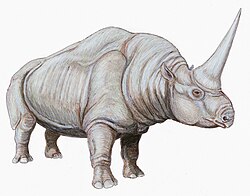| Protaceratherium | |
|---|---|
 | |
| P. minutum skeleton | |
| Scientific classification | |
| Kingdom: | Animalia |
| Phylum: | Chordata |
| Class: | Mammalia |
| Order: | Perissodactyla |
| Family: | Rhinocerotidae |
| Genus: | † Protaceratherium Abel, 1910 [1] |
| Species | |
| |
Protaceratherium is an extinct genus of rhinocerotid from the Oligocene and Miocene of Eurasia. [2]
It was a primitive, lightly built rhinoceros that was adapted to running. [3]









